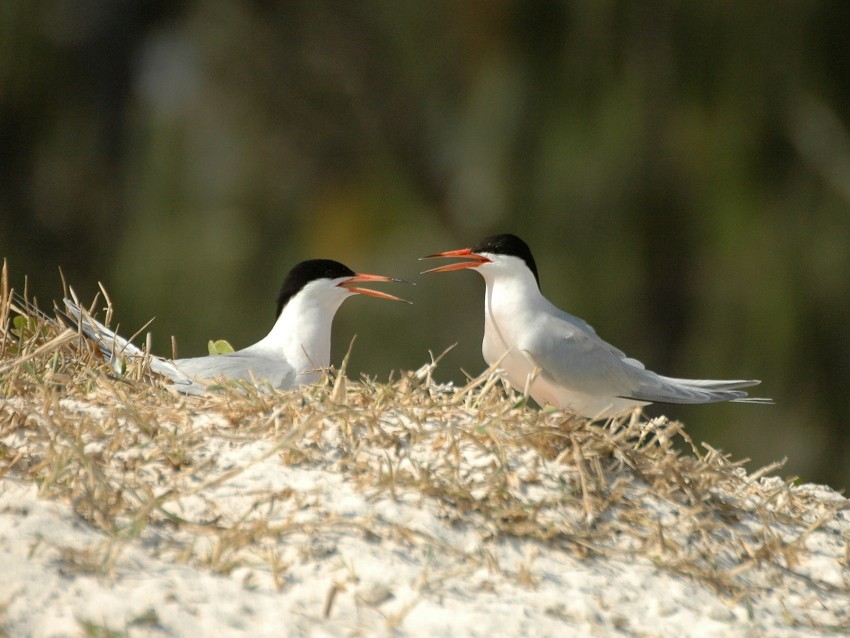Roseate Tern
A species of Typical Terns Scientific name : Sterna dougallii Genus : Typical Terns
Roseate Tern, A species of Typical Terns
Botanical name: Sterna dougallii
Genus: Typical Terns
Content
Description General Info
 Photo By Aviceda , used under CC-BY-SA-3.0 /Cropped and compressed from original
Photo By Aviceda , used under CC-BY-SA-3.0 /Cropped and compressed from original Description
This is a small-medium tern, 33–36 cm (13–14 in) long with a 67–76 cm (26–30 in) wingspan, which can be confused with the common tern, Arctic tern, and the larger, but similarly plumaged, Sandwich tern. The roseate tern's thin sharp bill is black, with a red base which develops through the breeding season, and is more extensive in the tropical and southern hemisphere races. It is shorter-winged and has faster wing beats than common or Arctic tern. The upper wings are pale grey and its under parts white, and this tern looks very pale in flight, like a small Sandwich tern, although the outermost primary flight feathers darken during the summer. The adults have very long, flexible tail streamers and orange-red legs. In summer, the underparts of adults take on the pinkish tinge which gives this bird its name. 
Size
32-39 cm (12.5-15.5 in)
Colors
Black
Gray
White
Life Expectancy
16 years
Nest Placement
Ground
Clutch Size
1 - 5 eggs
Feeding Habits
Roseate Tern primarily consume small fish such as sandlance, anchovies, herring, and mackerel through plunge-diving. They forage from coastal areas to deep waters, sometimes stealing prey from other seabirds. During courtship, males present fish to females. Besides fish, roseate Tern may eat insects, squid, crustaceans, and exhibit kleptoparasitism, especially during adverse weather.
Habitat
Roseate Tern's natural habitat predominantly spans coastal environments where they forage in salt bays, estuaries, and the open ocean. They breed on secluded parts of sandy or rocky islands and saltmarshes, often near other terns. Their nesting sites are amongst rocks and dense coastal vegetation, or, less commonly, on man-made gravel structures. During migration, they frequent open beaches and coastal inlets, usually over regions abundant with prey.
Nest Behavior
Pairs collaboratively select nest sites. Roseate Tern frequently use artificial nest boxes in certain regions. Nest construction evolves with added materials over weeks during incubation and brooding.
Nest Characteristics
Roseate Tern typically nest on the ground near vegetation or notable landscape features. Some also use cliffs or ledges. Nests, initially simple ground scrapes 2.4-4.8 inches wide, may be augmented with shell, rock, or vegetation.
Dite type
Piscivorous
General Info
Feeding Habits
Bird food type
Sounds
Call
Recording location: Japan
Call
Recording location: Japan
Behavior
Roseate Tern engage in elaborate courtship displays post-arrival at breeding grounds, involving aerial acrobatics like the 'High Flight,' where pairs ascend sharply, then glide down in a synchronized dance, sometimes joined by other terns. Males flaunt prey during courtship, perform ritual feedings to females at the nest, and defend their mates vigorously from competitors. These birds are predominantly monogamous, some maintaining partnerships for years. Surprisingly, in colonies with skewed sex ratios, female-female pairing occurs, with both sharing incubation and chick defense duties equally. Daily life centers around social interactions within colonies, resourceful foraging, and meticulous parental care.
Species Status
In the late 19th century, these birds were hunted for their plumes which were used to decorate hats. More recently, their numbers have decreased in some regions due to increased competition and predation by large gulls, whose numbers have increased in recent times. This species, as of 2019, is the UK's rarest breeding seabird. The largest European colony, accounting for more than 75% of the European population, is in Ireland, at Rockabill Island, County Dublin. In 2013, 1213 pairs nested at Rockabill. The colony at Lady's Island Lake, County Wexford, is also of crucial importance, with 155 pairs nesting there in 2013. With their favouring partly hidden nest sites, the provision of nestboxes has proven a dramatic conservation success, with the birds taking to them very readily. This results in greatly increased breeding productivity with the protection given to the young from predatory birds like herring gulls. At one colony on Coquet Island, Northumberland, the population rose from 25 pairs (1997) to 92 pairs (2005) after nestboxes were provided. Similar measures have been undertaken at the Anglesey tern colonies along with clearance of vegetation, in particular Tree Mallow. In 2018, for the first time in more than a decade, a pair fledged two chicks on the Skerries, off Anglesey after a RSPB project over previous years involving wardening, newly designed nest boxes being placed strategically around the islands along with lures playing roseate tern calls and hand-made decoys. In the UK the roseate tern has been designated for protection under the official government's national Biodiversity Action Plan. One of the main reasons given in the UK plan for threat to the species is global warming, creating an alteration of vertical profile distribution for its food source fishes. The roseate tern is one of the species to which the Agreement on the Conservation of African-Eurasian Migratory Waterbirds (AEWA) applies. The Canadian Wildlife Service lists the roseate tern as Threatened. The U.S. Department of Interior lists the northeastern population as Endangered and the Caribbean population as Threatened. 